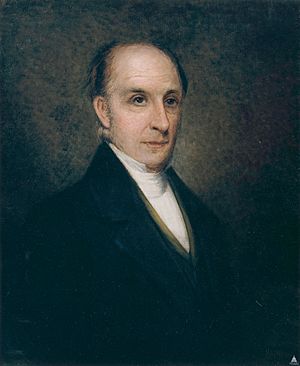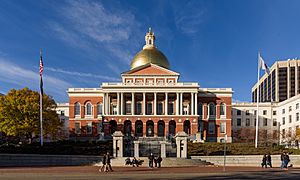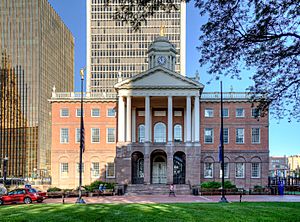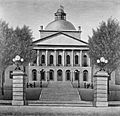Charles Bulfinch facts for kids
Quick facts for kids
Charles Bulfinch
|
|
|---|---|
 |
|
| Architect of the Capitol | |
| In office January 6, 1818 – June 25, 1829 |
|
| President | James Monroe John Quincy Adams Andrew Jackson |
| Preceded by | Benjamin Henry Latrobe |
| Succeeded by | Thomas U. Walter |
| Personal details | |
| Born | August 8, 1763 Boston, Massachusetts Bay Colony |
| Died | April 15, 1844 (aged 80) Boston, Massachusetts, U.S. |
| Nationality | American |
| Parents |
|
| Profession | Civil Engineer |
Charles Bulfinch (born August 8, 1763 – died April 15, 1844) was an important early American architect. Many people consider him the first professional architect born in America.
Charles Bulfinch: A Pioneer American Architect
Charles Bulfinch spent his career working in his hometown of Boston, Massachusetts, and in Washington, D.C.. In Washington, he was the Commissioner of Public Building. He helped build the middle section and dome of the United States Capitol. His buildings are known for being simple, balanced, and elegant. He helped create the unique Federal style of architecture. This style used classical domes, columns, and decorations. It was very popular in early 19th-century American architecture.
Bulfinch's Early Life and Education
Charles Bulfinch was born in Boston. His father, Thomas Bulfinch, was a well-known doctor. His mother was Susan Apthorp. When he was 12, Charles watched the Battle of Bunker Hill from his home. His house was on the Boston side of the Charles River.
He went to Boston Latin School and then Harvard University. He earned his first degree in 1781 and a master's degree in 1784.
Traveling and Learning in Europe
From 1785 to 1788, Bulfinch went on a "grand tour" of Europe. He visited London, Paris, and major cities in Italy. He was greatly inspired by the Renaissance architect Andrea Palladio. He also loved the classical buildings in Italy. He admired the neoclassical buildings by architects like Sir Christopher Wren and Robert Adam in the United Kingdom. While in Europe, Thomas Jefferson became a kind of mentor to him.
When he returned to the United States in 1787, he helped promote a ship called the Columbia Rediviva. This ship, led by Captain Robert Gray, was the first American ship to sail around the world. In 1788, Charles married his first cousin, Hannah Apthorp. Their sons included Thomas Bulfinch, who wrote Bulfinch's Mythology, and Stephen Greenleaf Bulfinch, a religious writer.
Bulfinch's Architectural Career


Bulfinch's first building was the Hollis Street Church in 1788. Some of his other early projects include:
- A memorial column on Beacon Hill (1789). This was the first monument to the American Revolution.
- The Federal Street Theatre (1793).
- The "Tontine Crescent" (1793–1794), which was a curved row of houses. It was later torn down.
- The Old State House in Hartford, Connecticut (1796).
- The Massachusetts State House (1798).
In 1791, he was chosen as a Fellow of the American Academy of Arts and Sciences.
Designing Homes and Churches
Over ten years, Bulfinch designed many private homes in the Boston area. These included:
- Joseph Barrell's Pleasant Hill (1793).
- Three houses in Boston for Harrison Gray Otis (1796, 1800, 1806).
- The John Phillips House (1804).
He also designed several churches in Boston. The New North church (built 1802–1804) is the only one still standing.
Improving Boston's Infrastructure
Bulfinch served on Boston's board of selectmen (like a city council) from 1791 to 1795. He left for a short time but returned in 1799. From 1799 to 1817, he was the chairman of the board. He also worked as a paid police superintendent. He helped improve Boston's streets, drains, and lighting. Under his leadership, Boston's public areas were changed to a grand, classical style.
Bulfinch designed the Boston Common. He also updated and enlarged Faneuil Hall (1805). He oversaw the building of India Wharf. During these years in Boston, he also designed:
- The Massachusetts State Prison (1803).
- Boylston Market (1810).
- University Hall for Harvard University (1813–1814).
- First Church of Christ, Unitarian in Lancaster, Massachusetts (1815–1817).
- The Bulfinch Building at Massachusetts General Hospital (1818). This building is famous for its Ether Dome.
Even with all this work, Bulfinch faced financial difficulties several times, starting in 1796. He received only $1,400 for designing the State House.
Architect of the U.S. Capitol
In the summer of 1817, President James Monroe visited Boston. Bulfinch spent a lot of time with him. A few months later, in 1818, President Monroe chose Bulfinch to be the next Architect of the Capitol in Washington, D.C. He took over from Benjamin Henry Latrobe. The Capitol Building had been partly burned by the British in 1814. Bulfinch was paid $2,500 per year plus expenses for this job.
As Commissioner of Public Building, Bulfinch finished the Capitol's wings and central part. He designed the western entrance and portico. He also built the Capitol's first low wooden dome. This dome was later replaced by the current cast-iron dome in the 1860s. In 1829, Bulfinch finished building the Capitol. This was 36 years after its cornerstone was first laid.
While in Washington, Bulfinch also drew plans for the State House in Augusta, Maine (1829–1832). He also designed a church and a prison in Washington, D.C. In 1827, he became an Honorary member of the National Academy of Design. He returned to Boston in 1830. He passed away on April 15, 1844, at the age of 80. He was buried in King's Chapel Burial Ground in Boston, but his tomb was later moved to Mount Auburn Cemetery in Cambridge, Massachusetts. In 1943, a United States Liberty ship was named the SS Charles Bulfinch in his honor.
Notable Designs by Charles Bulfinch
Here are some of the buildings and projects designed by Charles Bulfinch. Designs marked with an asterisk (*) are thought to be his, but it's not fully confirmed.
- Second meeting house of the Hollis Street Church (1788), Boston, Massachusetts
- Meeting House (1789- 1792), Taunton, Massachusetts
- Bulfinch Church (1790-1793), Pittsfield, Massachusetts
- Beacon Hill Memorial (1791), Boston, Massachusetts
- Joseph Coolidge House (1792), Boston, Massachusetts
- Federal Street Theatre (1793), Boston, Massachusetts
- Tontine Crescent (1793-95), Boston, Massachusetts
- First Harrison Gray Otis House (1795–96), Boston, Massachusetts
- Massachusetts State House (1795–1798), Boston, Massachusetts
- Old Connecticut State House (1796), Hartford, Connecticut
- Dedham Community House (1798), Dedham, Massachusetts
- Second Harrison Gray Otis House (1800–1802), Boston, Massachusetts
- Holy Cross Church (1800-1803), Boston, Massachusetts
- Worcester County Courthouse (1801-1803) Worcester, Massachusetts
- St. Stephen's Church (1802-1804), Boston, Massachusetts
- Amory–Ticknor House (1804), Boston, Massachusetts
- Nichols House (1804), Boston, Massachusetts
- 51–57 Mount Vernon Street (1804), Boston, Massachusetts
- Samuel Gridley and Julia Ward Howe House* (1804-1805), Boston, Massachusetts
- 13-17 Chestnut Street (1804-1805), Boston, Massachusetts
- Newburyport Superior Courthouse (1805), Newburyport, Massachusetts
- Stoughton Hall, Harvard University (1805), Cambridge, Massachusetts
- Third Harrison Gray Otis House (1806), Boston, Massachusetts
- Faneuil Hall expansion (1806), Boston, Massachusetts
- Quarters A, Brooklyn Navy Yard* (1805-1806), Brooklyn, New York
- Second steeple of Old North Church* (1806), Boston, Massachusetts
- India Wharf (1807), Boston, Massachusetts
- 87 Mount Vernon Street (1807), Boston, Massachusetts
- Third meeting house of the Federal Street Church (1809), Boston, Massachusetts
- Massachusetts Bank (1809) Boston, Massachusetts
- Boylston Market (1810), Boston, Massachusetts
- Suffolk County Courthouse (1810), Boston, Massachusetts
- Essex Bank (1811), Salem, Massachusetts
- University Hall, Harvard University (1813–1815), Cambridge, Massachusetts
- New South Church (1814), Boston, Massachusetts
- Manufacturers & Mechanics Bank (1814-1815), Boston, Massachusetts
- Middlesex County Courthouse (1814-1816), Cambridge, Massachusetts
- First Church of Christ, Unitarian (1816), Lancaster, Massachusetts
- Salem Town Hall (1816–17), Salem, Massachusetts
- Chapel and library, Andover Theological Seminary (1817-1818), Andover, Massachusetts
- Massachusetts General Hospital, Bulfinch Building (1818-1823), Boston, Massachusetts
- United States Capitol alterations (1822-1823), Washington, D.C.
- First Unitarian Church (1821-1822), Washington, D.C
- The George Washington University, Columbian College (1821-1822), original building, Washington, D.C.
- U.S. Capitol Gatehouses and Gateposts (1827), Washington, D.C.
- Maine State House (1832), Augusta, Maine
Gallery of designs
-
1st Harrison Gray Otis House, 141 Cambridge Street
-
2nd Harrison Gray Otis House, 85 Mount Vernon Street
-
Tontine Crescent, Boston
-
Faneuil Hall expansion.
-
United States Capitol, 1846
See also
 In Spanish: Charles Bulfinch para niños
In Spanish: Charles Bulfinch para niños












